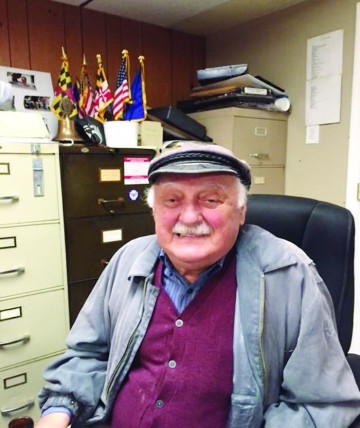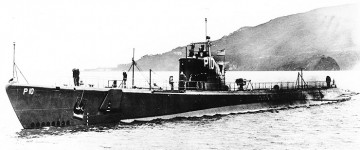A Noble Obsession
You would sit down cautiously with Fred Bumgarner at a poker table (usage of which can neither be denied nor confirmed) at the Stallings-Williams American Legion Post 206 in Chesapeake Beach. His gaze does not betray his thoughts. But the tight-handed former naval cryptologist is flush with heart when it comes to remembering our past and present veterans — even the ones whose only legacy is their discharge papers.
“I was going through old files,” Bumgarner says, “and asking fellas, Who was this guy? What was his story? Sometimes I could find out something, and sometimes I couldn’t. But it always hit me hard that we didn’t find out before they were gone from us.”
Bumgarner, 70, has been an American Legion member for 44 years. Since coming to Calvert County in 1980, he’s held several positions at Post 206, with membership in the 800s. Since becoming its historian two years ago, Bumgarner contributes Untold Stories to the Post’s quarterly newsletter: paragraph-sized biographical snippets gleaned from DD-214 discharge papers and membership cards. They are informative, anonymous, way too short, somewhat saddening, yet an inspirational source for reflection of the sacrifices made by the men and women of our military forces.
I was a WWII Army veteran serving in the Pacific …
I was a Korean War veteran flying missions in the Air Force …
I was a Marine veteran of Vietnam from 1963 …
“It means a lot more than it says,” Bumgarner reminds us. “It’s not a lot of info, but it’s something that we can document for these men and women who served their country.”
Every once in a while, Bumgarner gets the whole story. He feels especially grateful to interview a veteran whose stories wouldn’t otherwise have a home.
“I meet a lot of great people with some absolutely astonishing real-life stories, and I’m compelled to get them written down,” the biographer says.
Bumgarner sees veterans as a whole no matter where they are from, no matter who they may be. His story collection is broad, inclusive and intriguing. Here are Memorial Day snippets of stories Bumgarner has written from interviews with three local veterans.
J Rosalie Hanley-Safreed J
Women’s Army Corps
Rosalie was born on Armistice Day, November 11, 1920, just two years after the end of World War I, a conflict in which her father, Daniel J. Hanley, served. She and her three brothers were raised in Benwood, West Virginia, along the Ohio River in coal and steel country near Wheeling.
Rosalie failed her initial physical to join the Women’s Army Auxiliary Corps, but she was eventually accepted and became one of the first of 150,000 women who would serve in the WAACs renamed the Women’s Army Corps in July, 1943.
She was the WAC editor of newsletters at both the Fort Des Moines and Mitchel Field, on Long Island.
As the wounded arrived on stretchers, she and other WACs used their time off to help the Army nurses tend their patients. The wounded often attracted high-level VIPs, including movie stars and politicians. Rosalie was thrilled to meet Gary Cooper and Bob Hope. She also got to meet First Lady Eleanor Roosevelt.
In July 1944, while stationed at Mitchel Field, Rosalie received word that her brother Duke was killed in action at St. Lo, France, in the Normandy invasion. In 2011, Rosalie traveled to Normandy, visited the areas where Duke had served and was given a medal and award by the French government in honor of her brother for his ultimate sacrifice and the liberation of France from the Germans.
At 96, Rosalie is still going strong.
When you think of the changes our society has been through in her lifetime, it really makes you stop and take notice. Women are now an accepted and valued component of all volunteer forces, and with some exceptions, they serve on an equal footing with their male counterparts.
J Walter Dubicki J
Polish Refugee, British Army, United States Navy
Walter was born in Rudinia, Poland, on February 8, 1935. In 1943, during World War II, the German Army relocated his family to various slave labor camps in Nazi Germany, splitting them up. He remembers they were forced to burn down their own farm before leaving.
They were loaded onto cattle cars and sent to camps at Dortmund and later Siegen, both northwest of Frankfurt. It was a coal-mining region; Germany used more than 15 million people as slave laborers during the war, amounting to 20 percent of the German workforce.

After the war, first the English and then Americans took control of their Displaced Persons camp. His father was a cook for the soldiers. As a young boy he remembers he and his brother Johnny standing in the food lines with the GIs. They lived off the care packages provided by the American Army.
After the war, Walter joined the British Army and went to boot camp as part of an all-Polish unit. They lived in former German POW barracks and were given jobs as guards or performed other work around the camp. He served for five years.
From a young age he had a gift for languages, learning Polish, Russian, Ukrainian, English and German. He eventually transferred from the British Army to the U.S. Navy and took citizenship and English language classes.
He was relocated to Le Havre, France, where he learned that family members — already resettled in the United States — were sponsoring him for U.S. citizenship as a war refugee. He boarded the SS United States at Le Harve and made the July 1952 crossing in record time.
In 1956, he joined the U.S. Navy, where he served for eight years as a machinist mate on various vessels including the USS Randolph (CVA-15), USS Blandy (DD-943) and USS Decatur (DD-945). While on the USS Blandy, Walter became involved in the Cuban Missile Crisis in late October and early November 1962.
On October 30, the Blandy, working with patrol aircraft, established radar contact with a surfaced Russian Foxtrot class submarine (B-130). The B-130 submerged and for the next 14 hours the Blandy tracked the sub and eventually forced it to the surface. At the time, it was not known that four submarines carried nuclear tipped torpedoes and that the Soviet navy had given authorization for their use in the event of attacks by U.S. vessels.
During this engagement, Blandy commanding officer Edward G. ‘Shotgun’ Kelley relied on Walter as a Russian interpreter. At one point Walter spoke directly to Bobby Kennedy, the U.S. Attorney General and brother to JFK, relaying the Soviet sub commander’s intentions to the executive committee at the White House. Experiencing troubles with her diesel engines, the Russian sub turned and headed away from Cuba, closely monitored by the U.S. task force.
After Walter’s discharge on November 17, 1964, he got a job in New York helping build the World Trade Center towers. When the second tower was 85 percent complete, his company relocated him to Washington, D.C., where it was building the new Soviet embassy. In his spare time he pursued a private pilot’s license with former WWII Navy fighter ace Robert A. Clark Jr. and later formed his own construction company with Clark, Dubicki and Clark.
He joined Post 206 when he moved to Fairhaven, where he lived until his death in February, 2018.
J Ronald C. Heister J
U.S. Naval Submariner
In December of 2014, I attended a viewing at a local funeral home for the father of a friend and former coworker of my wife. I had never met the gentleman, Ronald Heister, but I was aware that he was a resident at Charlotte Hall Veterans Home in St. Mary’s County. After leaving the funeral home that evening, I could not get this veteran’s story out of my head, so I would like to share it with you. I think you will agree that it is quite a tale of service and fate.
The first thing I noticed was a dress-blue Navy jumper in a frame standing next to the coffin, with the insignia of a Storekeeper 2nd Class on the sleeve. A small picture of a very young couple was at the bottom of the frame with a note indicating that it was taken in early 1942 at the time the couple became engaged and just before he had shipped out to the Pacific to serve aboard the USS Pompano. There were two hats in the coffin: one an American Legion hat with the words Rock Hall for his home Post 228 on Maryland’s Eastern Shore; the other a baseball cap with USS Pompano, SS-181 emblazoned in gold letters.

When the Pompano headed out on patrol July 28, 1943, Heister had remained at the naval base with severe dental problems. The Pompano never returned from that mission.
On a website dedicated to the memory of the crew is a notation that Heister “was ashore for some dental work and was not with his shipmates when their boat was lost. He lives for the memory of the men he served with.”
As I looked over the room at three generations of his family, I thought what a wonderful outcome, but I also thought of the burden that Heister carried in silence for the remainder of his life.
